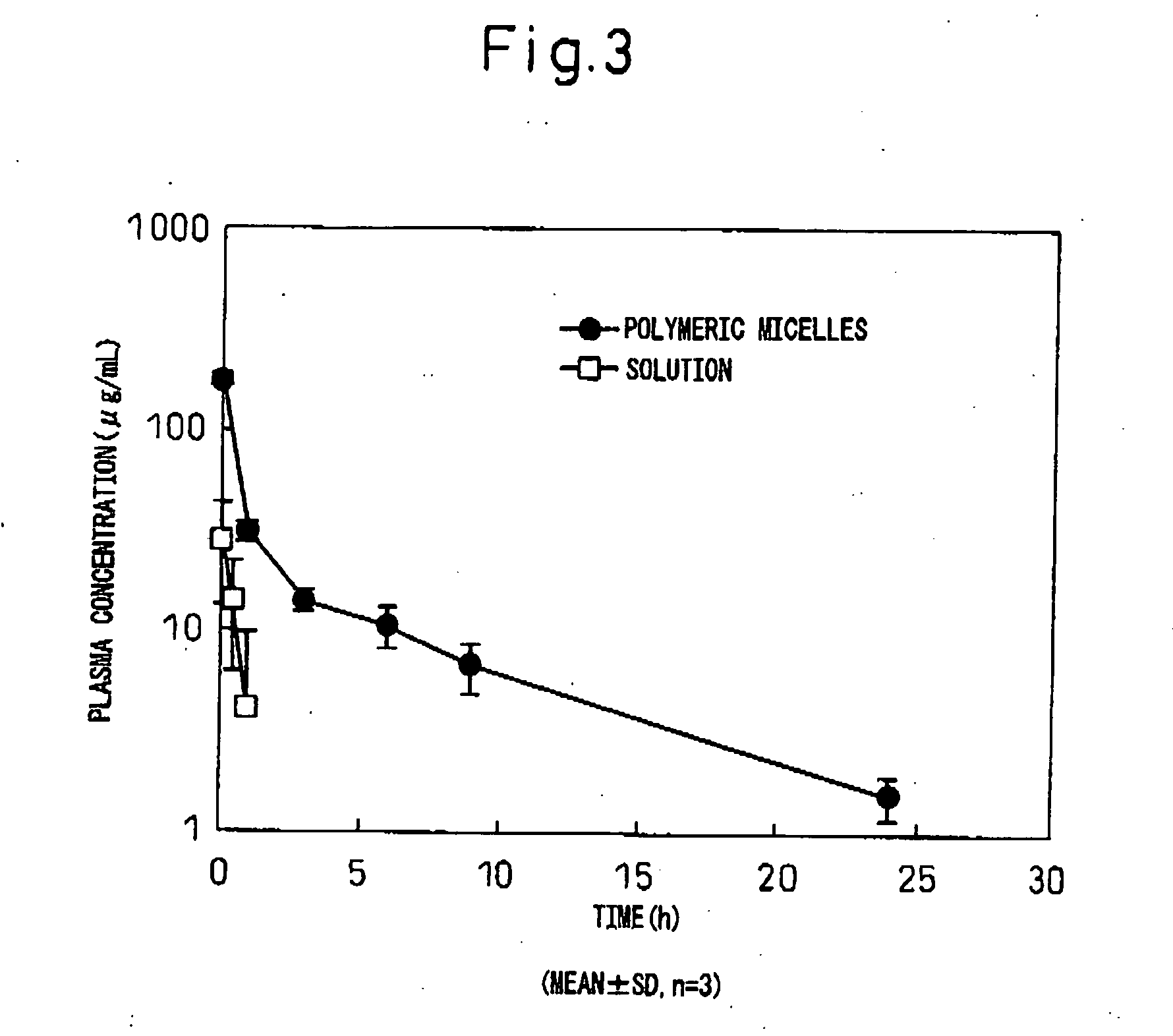Physiologically Active Polypeptide- or Protein-Encapsulating Polymer Micelles, and Method for Production of the Same
- Summary
- Abstract
- Description
- Claims
- Application Information
AI Technical Summary
Benefits of technology
Problems solved by technology
Method used
Image
Examples
example 1
Human IgG-Encapsulating Micelle Preparation 1
[0063]The block copolymer used was polyethylene glycol-co-polyaspartic acid benzyl ester (hereinafter, PEG-PBLA. In this polymer, the aspartic acid residues without benzyl esters are of general formula (I) wherein R5 is —O— and R6 is hydrogen (same hereunder). Also, all of the following block copolymers are of general formula (I) wherein R1 is CH3, L1 is —O—(CH2)3NH and R2 is COCH3. After precisely weighing out 10 mg of PEG-PBLA 12-50(65) into a glass vial, 1 ml of dichloromethane was added for dissolution. The solution was dried into a film under a nitrogen gas stream, and then further dried for about 1 hour under reduced pressure. To this there was added 62 μL of a 20 mM phosphate buffer (pH 6, 16.5 mg / mL) solution containing purified human IgG (MP Biomedicals Co.) (pI: approximately 8), and then 1.938 mL of 20 mM phosphate buffer (pH 6) or 20 mM TAPS buffer (pH 8) was slowly added while gently stirring at 4° C. After stirring overnight...
example 2
Human IgG-Encapsulating Micelle Preparation 2
[0065]The block copolymer used was polyethylene glycol-co-polyglutamic acid benzyl ester (hereinafter, PEG-PBLG. In this polymer, the glutamic acid residues without benzyl esters are of general formula (I) wherein R5 is —O— and R6 is hydrogen (same hereunder)). After precisely weighing out 10 mg of PEG-PBLG 12-40(65) into a glass vial, 1 mL of dichloromethane was added for dissolution. The solution was dried into a film under a nitrogen gas stream, and then further dried for about 1 hour under reduced pressure. To this there was added 62 μL of a phosphate buffer solution (pH 6, 16.5 mg / mL) containing purified human IgG (MP Biomedicals Co.) (pI: approximately 8), and then 1.938 mL of 20 mM phosphate buffer (pH 6) or 20 mM TAPS buffer (pH 8) was slowly added while gently stirring at 4° C. After stirring overnight at 4° C., a Biodisruptor (High Power Unit, product of Nissei Corp.) was used for sonication for about 10 seconds (1 second interm...
example 3
Human IgG-Encapsulating Micelle Preparation 3
[0067]The block copolymer used was polyethylene glycol-co-polyaspartic acid octyl ester (hereinafter, PEG-POLA. In this polymer, the aspartic acid residues without octyl esters are of general formula (I) wherein R5 is —O— and R6 is hydrogen (same hereunder)). After precisely weighing out 10 mg of PEG-POLA 12-40(65) into a glass vial, 1 mL of dichloromethane was added for dissolution. The solution was dried into a film under a nitrogen gas stream, and then further dried for about 1 hour under reduced pressure. To this there was added 62 μL of a 20 mM phosphate buffer (pH 6, 16.5 mg / mL) solution containing purified human IgG (MP Biomedicals Co.) (pI: approximately 8), and then 1.938 mL of 20 mM phosphate buffer (pH 6) or 20 mM TAPS buffer (pH 8) was slowly added while gently stirring at 4° C. After stirring overnight at 4° C., a Biodisruptor (High Power Unit, product of Nissei Corp.) was used for sonication for about 10 seconds (1 second in...
PUM
| Property | Measurement | Unit |
|---|---|---|
| Fraction | aaaaa | aaaaa |
| Acidity | aaaaa | aaaaa |
| Hydrophilicity | aaaaa | aaaaa |
Abstract
Description
Claims
Application Information
 Login to View More
Login to View More - R&D
- Intellectual Property
- Life Sciences
- Materials
- Tech Scout
- Unparalleled Data Quality
- Higher Quality Content
- 60% Fewer Hallucinations
Browse by: Latest US Patents, China's latest patents, Technical Efficacy Thesaurus, Application Domain, Technology Topic, Popular Technical Reports.
© 2025 PatSnap. All rights reserved.Legal|Privacy policy|Modern Slavery Act Transparency Statement|Sitemap|About US| Contact US: help@patsnap.com



